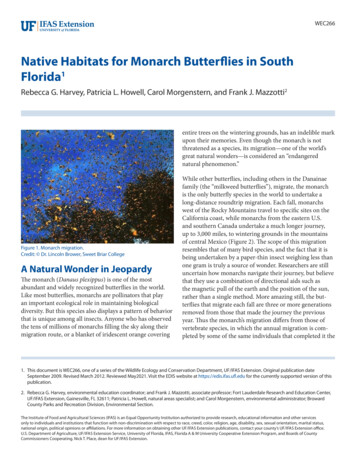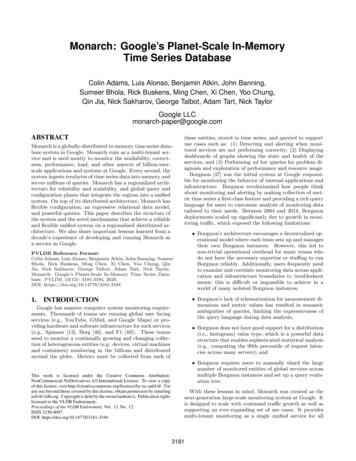
Transcription
WEC266Native Habitats for Monarch Butterflies in SouthFlorida1Rebecca G. Harvey, Patricia L. Howell, Carol Morgenstern, and Frank J. Mazzotti2entire trees on the wintering grounds, has an indelible markupon their memories. Even though the monarch is notthreatened as a species, its migration—one of the world’sgreat natural wonders—is considered an “endangerednatural phenomenon.”Figure 1. Monarch migration.Credit: Dr. Lincoln Brower, Sweet Briar CollegeA Natural Wonder in JeopardyThe monarch (Danaus plexippus) is one of the mostabundant and widely recognized butterflies in the world.Like most butterflies, monarchs are pollinators that playan important ecological role in maintaining biologicaldiversity. But this species also displays a pattern of behaviorthat is unique among all insects. Anyone who has observedthe tens of millions of monarchs filling the sky along theirmigration route, or a blanket of iridescent orange coveringWhile other butterflies, including others in the Danainaefamily (the “milkweed butterflies”), migrate, the monarchis the only butterfly species in the world to undertake along-distance roundtrip migration. Each fall, monarchswest of the Rocky Mountains travel to specific sites on theCalifornia coast, while monarchs from the eastern U.S.and southern Canada undertake a much longer journey,up to 3,000 miles, to wintering grounds in the mountainsof central Mexico (Figure 2). The scope of this migrationresembles that of many bird species, and the fact that it isbeing undertaken by a paper-thin insect weighing less thanone gram is truly a source of wonder. Researchers are stilluncertain how monarchs navigate their journey, but believethat they use a combination of directional aids such asthe magnetic pull of the earth and the position of the sun,rather than a single method. More amazing still, the butterflies that migrate each fall are three or more generationsremoved from those that made the journey the previousyear. Thus the monarch’s migration differs from those ofvertebrate species, in which the annual migration is completed by some of the same individuals that completed it the1. This document is WEC266, one of a series of the Wildlife Ecology and Conservation Department, UF/IFAS Extension. Original publication dateSeptember 2009. Revised March 2012. Reviewed May2021. Visit the EDIS website at https://edis.ifas.ufl.edu for the currently supported version of thispublication.2. Rebecca G. Harvey, environmental education coordinator; and Frank J. Mazzotti, associate professor; Fort Lauderdale Research and Education Center,UF/IFAS Extension, Gainesville, FL 32611; Patricia L. Howell, natural areas specialist; and Carol Morgenstern, environmental administrator; BrowardCounty Parks and Recreation Division, Environmental Section.The Institute of Food and Agricultural Sciences (IFAS) is an Equal Opportunity Institution authorized to provide research, educational information and other servicesonly to individuals and institutions that function with non-discrimination with respect to race, creed, color, religion, age, disability, sex, sexual orientation, marital status,national origin, political opinions or affiliations. For more information on obtaining other UF/IFAS Extension publications, contact your county’s UF/IFAS Extension office.U.S. Department of Agriculture, UF/IFAS Extension Service, University of Florida, IFAS, Florida A & M University Cooperative Extension Program, and Boards of CountyCommissioners Cooperating. Nick T. Place, dean for UF/IFAS Extension.
previous year, and their offspring. Birds and mammals learnmigratory routes from their parents, but monarchs don’tlive long enough to “teach” their children how to migrate!The migratory generation originates in the fall with adultsliving for eight or nine months, just long enough to travel toMexico or California, endure the winter, and return to thesouthern U.S. to lay eggs before dying. Over the summer,three or four generations of monarchs are produced. Thesesummer generations have a much shorter lifespan than themigratory generation—only three to five weeks becausethey devote much of their resources to reproduction. By theend of the summer, the third or fourth generations maketheir way back to the place their grandparents or greatgrandparents came from the previous spring.monarchs from northeastern North America, but there arecompeting hypotheses regarding how these migrants travelto, from, or through Florida.According to Dr. Karen Oberhauser, Florida is a terminaldestination for migrating monarchs from the northeasternUnited States and southeastern Canada. She posits thatthese monarchs fly into Florida but don’t disperse out, making the Florida population a “sink population.” In southernFlorida in particular, the warm climate likely stimulatesmonarchs’ reproductive behavior, which upsets hormonalbalance and causes them to lose their ability to migratenorth. Thus monarchs that migrate to southern Floridamay stay and become part of the local breeding populations. Recent research by Cristina Dockx and colleagues,however, suggests that some migrants start to return northeach spring, and after several successive generations theyeventually reach their natal grounds in northeastern NorthAmerica.Figure 2. Fall migrations of the monarch butterfly in North America(Brower 1995).In addition to repopulating the continent, the longdistance migration serves to keep the monarch populationgenetically healthy and relatively disease-free. However, themigration is now threatened by environmental factors suchas global warming, habitat loss at the wintering sites, theloss of milkweed plants along the migration route, and anincrease in naturalized tropical milkweeds in mild climates.The result could be the replacement of large migratorypopulations with smaller, less healthy remnant populationsthat stay in one location and breed year-round.Florida MonarchsBecause of the warm climate and continuous availability ofhost plants, much of Florida’s monarch population stays inthe state year-round and breeds continuously throughoutthe year. Year-round residents are more common insouthern Florida, as cold winter temperatures in northernFlorida can kill monarchs at any life stage. In additionto resident populations, the state also hosts migratoryNative Habitats for Monarch Butterflies in South FloridaFigure 3. Monarchs may migrate to Florida from the northeastern U.S.and Canada, then stay here and breed year-round.Credit: Patricia Howell, Broward County Parks and RecreationIt is also possible that Florida is a stopover for migratingmonarchs on their way to the Mexican wintering grounds(Figure 2). Migration from Florida to Mexico remainslargely hypothetical, but researcher Gary Noel Ross hasobserved thousands of monarchs on oil platforms in thecentral Gulf of Mexico, indicating that they cross fromLouisiana to northeastern Mexico each fall. However, arecent study by Elizabeth Howard and Andrew Davis foundthat monarch roosts along the East Coast flyway lagged2
behind roosts in the central U.S. flyway, suggesting thatmonarchs migrating down the East Coast are less likelyto make it to the Mexico wintering site. Christina Dockxand colleagues contend that monarchs found in St. MarksNational Wildlife Refuge (Florida panhandle) are headingto Mexico, whereas those found in southern Florida spendtheir winters either in southern Florida, Cuba, or otherareas of the Caribbean.There may not be enough milkweed habitats left to sustainmonarch populations at earlier levels. While year-to-yearcounts of monarchs vary widely, the World WildlifeFund-Mexico has detected a downward trend in size of theMexico winter colonies since the mid-1990s. In additionto loss of milkweeds throughout North America, illegallogging of forests on the Mexican wintering grounds is amajor threat to the population.Loss of Milkweeds Loss ofMonarchsCreating Monarch Habitat in SouthFloridaA butterfly’s range depends more on the availability ofhost plants for larvae than on nectar plants for adults, soprotecting larval hosts is a higher priority for butterflyconservation than is protecting the nectar plants thatappear in many butterfly gardens. The monarch’s larval hostplant is the milkweed (genus Asclepias), of which there aremore than 100 species across North America.One apparently obvious solution to the loss of monarchhabitat is to plant more milkweeds. Indeed, we can protectour monarch population by compensating for the lossof habitat, but how we create these habitats is important.Butterflies depend on particular microhabitats—smallareas within an ecosystem that have specific conditions andresources, such as vegetational structure, microclimate,moisture, and presence/absence of other animals (predatorsor competitors). Such close attention to particulars is especially important when creating habitat for non-migratorybutterflies (like many monarchs in south Florida), whichtend to spend their lives in a very small area and thus havemore specific habitat requirements than migrants.Milkweeds grow most abundantly in disturbed habitatssuch as agricultural landscapes and along roadsides, butthey are in decline for several reasons. Urban and suburbandevelopment is eliminating monarch habitat by supplantingagricultural landscapes where an estimated 90% of milkweeds occur. The increasing use of herbicides in agricultureis also leading to milkweed loss. The widespread use ofgenetically modified crops, such as herbicide-resistant cornand soybeans, exacerbates the problem because it enablesgrowers to indiscriminately spray their fields with herbicides rather than tilling to control weeds. The organizationMonarch Watch estimates that the adoption of geneticallymodified crops has led to the loss of more than 80 millionacres of monarch habitat. Along roadsides, the ubiquitoususe of herbicides and frequent mowing are also killingmilkweeds and hence eliminating vital monarch habitat.Figure 4. Florida has several native species of milkweeds, such asbutterflyweed (Asclepias tuberosa).Credit: Keith Bradley, Institute of Regional ConservationNative Habitats for Monarch Butterflies in South FloridaTo develop appropriate habitats for monarchs, we need tomove beyond thinking only about particular host speciestoward a focus on planting native communities. Backyardbutterfly garden programs usually do not encouragegardeners to consider nearby plant communities (forests,prairies, or parks) when choosing plants for their gardens.Such programs often promote homogenous plantings andtend to focus on species that have beautiful flowers, attractbutterflies, bloom year-round, and require little attention.This often means that they promote nonnative, potentiallyinvasive plant species. In fact, one of the most frequentlyrecommended plants for monarch gardens is an exoticspecies, scarlet milkweed (Asclepias curassavica, also knownas tropical milkweed or bloodflower).There are 21 native milkweed species in Florida and eightnative species in south Florida (see sidebar). While some ofthese species may not be quite as showy as A. curassavica,they work perfectly well as monarch attractants. Gardeners should rest assured that monarchs are well adaptedto consuming these native species. For example, whilebutterflyweed (A. tuberosa) has tougher leaves than scarletmilkweed (and in fact monarchs need to eat more of thisplant than other species to get the nutrients they need),3
caterpillars that eat only A. tuberosa grow just as well asthose that eat other species including A. curassavica.In addition to milkweeds, a monarch garden needs nectarplants to provide food for adult monarchs. See sidebar for alist of nectar plants that are native to south Florida.Figure 5. Native milkweed species play host to many butterfly species,such as this dark-morph female tiger swallowtail on butterflyweed.Credit: Kurt Volker, Broward County Parks and RecreationThe Threat of NonnativeMilkweedsScarlet milkweed is native to South America but hasbecome a naturalized weed in tropical and subtropical areasthroughout the world. Whereas most other milkweeds donot grow aggressively, scarlet milkweed has been found tobe self-compatible (individual plants can seed themselves)which enables it to spread more effectively. This speciesestablishes itself most readily in dry, sandy, disturbed areas,but also grows in mucky soils in swamps (such as CoconutCreek Maple Swamp in Broward County, Florida—seeFigure 6). It has become invasive—meaning it aggressivelytakes over habitat of native species—on many PacificIslands (e.g., Galápagos, Fiji, Society Islands, Hawaii) and insome Pacific Rim countries (e.g., Australia, China, Malaysia). In the continental U.S. it is established in Florida,Georgia, South Carolina, Tennessee, Louisiana, Texas, andsome coastal areas of southern California.All milkweeds contain toxins, called cardenolides, whichthe monarch has adapted to be able to ingest. These toxinsserve to protect both the plants and the monarchs frompredators. Scarlet milkweed contains much higher amountsof toxins than native milkweeds. Monarchs do not discriminate between Asclepias that have high or low toxicity;Native Habitats for Monarch Butterflies in South Floridahigher toxicity milkweed may hinder larval performance,but it may also provide additional protection from predation. More research into scarlet milkweed’s effects is neededbecause it may have adverse effects on monarchs that we donot yet understand.One clear harmful effect the increase in tropical milkweedsin mild climates has had on monarchs is the resultingestablishment of year-round monarch populations in newlocations, such as Bermuda and Texas. This developmentmight seem beneficial, but research at Emory Universitydemonstrated that migrating monarchs have a much loweroccurrence of parasites than those that do not migrate.Therefore, any new resident populations resulting froman increase in tropical milkweeds are likely to be heavilyinfected with parasites.In southern Florida, scarlet milkweed can be found growingwild in Palm Beach, Broward, Miami-Dade, Monroe, Leeand Hendry Counties, and in the Florida Keys. Althoughscarlet milkweed is not on the Florida Exotic Pest PlantCouncil’s (FLEPPC) list of invasive species, populationsare increasing throughout the state due to heavy plantingand seeds being transported by the wind. The species wascollected as early as 1936 in Florida, and by the 1960s itwas found along roadsides, then in pastures and weedylots, and had spread into natural areas by the 1990s. Scarletmilkweed has been observed in numerous southern Floridanatural areas including Coconut Creek Maple Swamp,Bill Baggs Cape Florida State Park, Big Cypress NationalPreserve, Castellow Hammock, Dupuis Reserve, CorkscrewRegional Ecosystem Watershed, J.W. Corbett WildlifeManagement Area, Everglades National Park, and Fisheating Creek Wildlife Management Area.Several plant species that were recommended for butterfliesin the 1980s and 1990s have become invasive and have beenadded to the FLEPPC list. These include, for example, blueporterweed (Stachytarpheta cayennensis), lantana (Lantanacamara), Christmas cassia (Senna pendula var. glabrata),two-flowered passion vine (Passiflora biflora), and Browne’sblechum (Blechum pyramidatum). With vigilance, we canlearn from the past and bring scarlet milkweed undercontrol before it becomes as invasive as these other species.Other plants that should be avoided in the monarch gardenare swallow-worts (genus Cynanchum). These plants havesimilar chemical properties to milkweeds and fool monarchs into laying eggs on them. However, swallow-worts arenot suitable food for monarch larvae, and caterpillars fail todevelop into pupae when feeding on these plants. In southFlorida there are four native species of Cynanchum.4
Native Larval Host Plants forMonarchs in South FloridaCurtiss’ milkweed (Asclepias curtisii)Swamp milkweed (Asclepias incarnata)Fewflower milkweed (Asclepias lanceolata)Longleaf milkweed (Asclepias longifolia)Savannah milkweed (Asclepias pedicellata)Butterflyweed (Asclepias tuberosa)Figure 6. Scarlet milkweed (Asclepias curassavica) invading a naturalarea in Coconut Creek Maple Swamp, Broward County, Florida.Credit: Patricia Howell, Broward County Parks and RecreationCreating Monarch Habitat alongthe Migration RouteOf course, the importance of planting native species formonarchs applies beyond Florida. Scarlet milkweed is notlikely to establish itself in northern climes because it cannotsurvive a cold winter; however, it has become naturalized asfar north as South Carolina and north-central California—areas that are along the major eastern and western monarchmigration routes. Planting nonnative milkweeds alongthe migration route can increase reproductive behaviorof monarchs and disrupt their migratory behavior. Thereare 108 native Asclepias species in North America—sowherever you live along the migration routes, there arenative species you can substitute for A. curassavica in amonarch garden. For lists of Asclepias species native toeach region of the U.S., visit http://plants.usda.gov/java/profile?symbol ASCLE.Whorled milkweed (Asclepias verticillata)Green antelopehorn (Asclepias viridis)White vine (Sarcostemma clausum)Native Nectar Plants for Monarchsin South FloridaMist flower (Conoclinium coelestinum)Cat’s tongue (Melanthera nivea)False blazing star (Carphephorus corymbosus)Flat-topped golden rod (Euthamia caroliniana)Yellow top (Flaveria linearis)Goldenrod (Solidago fistulosa, odora var. chapmanii,sempervirens or stricta)Spanish needles (Bidens alba or bipinnata)Blazing star (Liatris garberi, gracilis, or chapmanii)Climbing aster (Symphyotrichum carolinianum)Hempvine (Mikania cordifolia)Scorpiontail (Heliotropium angiospermumCrownbeard (Verbesina virginica)ReferencesFigure 7. Monarch chrysalis on native white vine (Sarcostemmaclausum) in south Florida.Credit: Sandy Granson, University of FloridaNative Habitats for Monarch Butterflies in South FloridaAltizer, S.M., K.S. Oberhauser, and L.P. Brower. 2000.Associations between host migration and the prevalence5
of a protozoan parasite in natural populations of monarchbutterflies. Ecological Entomology 25:125–139.(Lepidoptera: Danaidae), in Bermuda. Florida Entomologist72(3):494–499.Arceneaux, A., C. Corales, E. Torok, C. Minnix, and B.Zamponi. 2001. A comparison of Opryocystic elektroschirraspore loads on Danaus plexipuus (sic) likely reared onnative and non-native milkweeds. Monarch Lab Website.Updated March 2001. ies/Projects/Westview.aspxHoward, E., and A.K. Davis. 2008. The fall migrationflyways of monarch butterflies in eastern North Americarevealed by citizen scientists. Journal of Insect Conservation13(3):279–286.Brower, L.P. 1995. Understanding and misunderstandingthe migration of the monarch butterfly (Nymphalidae) inNorth America: 1857–1995. Journal of the Lepidopterists’Society 49(4):304–385.Cech, R. and G. Tudor. 2005. Butterflies of the East Coast:An Observer’s Guide. Princeton University Press, Princeton,New Jersey.Daniels, J. July 2009. Personal communication. Universityof Florida McGuire Center for Lepidoptera and Biodiversity, Florida Museum of Natural History.Dockx, C. Unpublished manuscript. Migratory phenotypictraits differences between two groups of eastern NorthAmerican monarch butterflies: Mexican vs. Florida-Cuban.University of Florida McGuire Center for Lepidoptera andBiodiversity, Florida Museum of Natural History.Emmel, T. June 2009. Personal communication. Universityof Florida McGuire Center for Lepidoptera and Biodiversity, Florida Museum of Natural History.Emory University. 2005, March 11. Emory Study FindsMonarch Health Tied To Migration. ScienceDaily. RetrievedOctober 9, 2009, from 9105725.htmErickson, J.M. 1973. The utilization of various Asclepiasspecies by larvae of the monarch butterfly, Danaus plexippus. Psyche, September 1973.Goehring, L., and K.S. Oberhauser. 2004. Environmentalfactors influencing postdiapause reproductive developmentin monarch butterflies. Pages 187–198 in K.S. Oberhauserand M.J. Solensky (editors), The Monarch Butterfly: Biologyand Conservation. Cornell University Press, Ithaca, NewYork.Journey North (2009, February 5). Migration Update: February 5, 2009. Retrieved May 12, 2009, from pdate020509.html#CompareMonarch Watch. 2008. Monarch Waystations: Create, Conserve, & Protect Monarch Habitats. Retrieved November 6,2008, from , K. November 2008. Personal communication.University of Minnesota, Department of Fisheries, Wildlifeand Conservation Biology.Ross, G.N. October 2009. Personal communication. BatonRouge, LA.Swengel, A. 2004. Straight talk about butterfly habitatmanagement. American Butterflies 12(1):16-22.Wyatt, R. and S.B. Broyles. 1997. The weedy tropicalmilkweeds Asclepias curassavica and A. fruticosa areself-compatible. Biotropica 29(2):232-234.Zalucki, M.P., S.B. Malcolm, T.D. Paine, C.C. Hanlon, L.P.Brower, and A.R. Clarke. 2001. It’s the first bites that count:survival of first-instar monarchs on milkweeds. AustralEcology 26:547-555.For more information contactFrank J. MazzottiUF/IFAS Fort Lauderdale Research & Education Center3205 College Ave., Davie, FL 33314Email: fjma@ufl.eduhttp://crocdoc.ifas.ufl.edu/Hilburn, D.J. 1989. A non-migratory, non-diapausingpopulation of the monarch butterfly, Danas plexippusNative Habitats for Monarch Butterflies in South Florida6
major threat to the population. Creating Monarch Habitat in South Florida One apparently obvious solution to the loss of monarch habitat is to plant more milkweeds. Indeed, we can protect our monarch population by compensating for the loss of habitat, but how we create these habitats is important. Butterflies depend on particular microhabitats .










